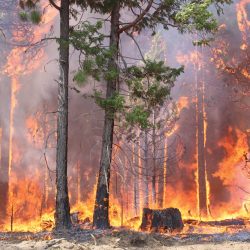Glaciers Are Shrinking — But How Much?
UW research charts the changing climate’s effect on global ice.

“We knew that glaciers ebbed and flowed in the past, so we wanted to learn how the behavior of glaciers today — melting due to human-caused climate change — stacks up against their long-term fluctuations,” says Andy Jones MS’21, PhDx’26, pictured at Bolivia’s Zongo Glacier with Yasmeen Orellana Salazar MS ’24 and Matias Romero PhDx’27. Ethan C. Parrish PhD’24
As they are in many places around the globe, glaciers perched high in the Andes Mountains are shrinking. UW–Madison researchers and their collaborators have uncovered evidence that the high-altitude tropical ice fields are likely smaller than they’ve been at any time since the last ice age ended 11,700 years ago.
That would make the tropical Andes the first region in the world known to pass that threshold as a result of the steadily warming global climate. It also makes them possible harbingers of what’s to come for glaciers globally.
Satellite imagery and on-the-ground observations have provided conclusive evidence for decades that high-altitude glaciers in the Andes are steadily shrinking as warmer temperatures cause them to melt more quickly than falling snow can replenish them. What has remained unclear, though, is how the shrinkage compares to the rest of the period that began at the end of the last ice age, known as the Holocene.
“We knew that glaciers ebbed and flowed in the past, so we wanted to learn how the behavior of glaciers today — melting due to human-caused climate change — stacks up against their long-term fluctuations,” says Andy Jones MS’21, PhDx’26, the study’s coauthor.
To answer this question, the team of scientists analyzed the geochemistry of bedrock from areas near the edges of four glaciers in the high tropical Andes, choosing sites that satellite imagery showed were exposed by melting ice in only the last two or three decades. This research points to a single likely conclusion, according to UW geoscience professor Shaun Marcott: the world’s tropical glaciers are the first to shrink beyond what’s been seen in the recent geologic past.
“Glaciers are very sensitive to the climate system that they live in,” says Marcott. “They really are the place you would look to see some of the first big changes resulting from a warming climate. You can look to these glaciers and imagine what we might be looking at going into the future in other places like the western United States, which is a no-ice scenario.”
Published in the Winter 2024 issue



Comments
No comments posted yet.